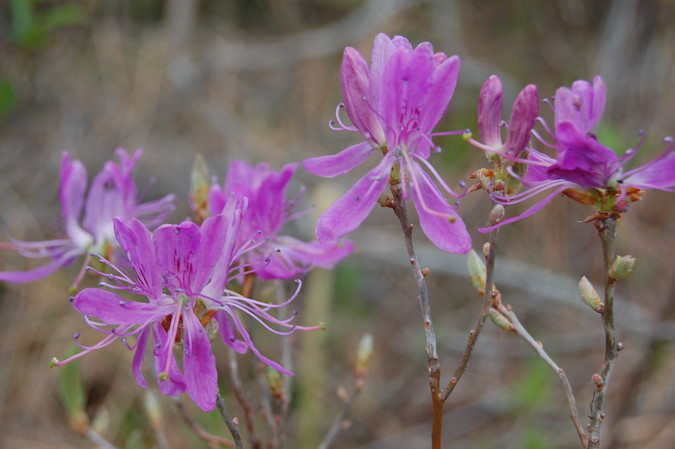The Wrack
The Wrack is the Wells Reserve blog, our collective logbook on the web.
The Wrack is the Wells Reserve blog, our collective logbook on the web.
A botanist’s perception of time is measured by the coming and going of flowers. We can’t stop it, but we have the ability to rewind it! All it takes is a trip…

Thomas J. Rawinski, botanist with the USDA Forest Service in Durham, New Hampshire, was among the presenters for last week's invasive plant workshop at the reserve. After a day in the auditorium and afield, he mused about his visit and reported on some of what he discovered while here. He was tickled to find lilacs and apples blossoming at the coast, since at his inland locale they had already gone by. And he found a variety of interesting species that don't always draw attention. Tom has kindly permitted us to share his notes and we're pleased to do so (with some light editing).
Today's workshop was in Wells, at Laudholm Farm, part of the Wells National Estuarine Research Reserve. If there is a more spectacular cultural/natural landscape in New England, I’ve yet to see it. What a place. I love it there. Everyone does.
Sue Bickford guided us through the shrublands of Laudholm Farm, where habitat restoration for the New England cottontail had occurred. The past and, to a certain extent, present impacts of too many deer on the landscape were discussed. I was delighted to see a single plant of red chokeberry (Aronia arbutifolia). I pointed it out to folks. We now had it confirmed from both Cumberland and York Counties. [Rawinski's friend and colleague, Roger Monthey, had discovered a population of the species in Falmouth last year, possibly the first confirmed record for Maine. — SR]
In a nearby wet meadow I found pale green orchis (Platanthera flava var. herbiola). It was one of the larger populations of this state Special Concern species that I have seen. Sue mentioned that counting and monitoring the plants would be a fine project for her dedicated corps of volunteers to pursue. We saw that one of the plants had already been chomped by a deer.
When the workshop was over Sue suggested that I visit their “mossy bog,” an enigmatic boggy wetland that supported nodding lady’s tresses (Sprianthes cernua) and dragon’s mouth (Arethusa bulbosa). Any opportunity to see Arethusa had to be taken! I donned my hip boots and was off!
Rhodora (Rhododendron canadense) was in fine bloom in the mossy bog. Near the edge of the boardwalk I photographed a clump of three Arethusa plants in bud. They are just as spectacular in bud as they are in flower!
In the area west of the boardwalk I did a double-take — “Wait, that’s small reed-grass (Calamagrostis cinnoides), the plant I’ve been yearning to see in Maine for decades!” Yes, indeed, here was another (new?) Special Concern plant for Laudholm Farm. The mossy bog proper had abundant black chokeberry (Aronia melanocarpa), but in the bordering shrubby vegetation the red chokeberry was frequent. Great!
My cell phone rang while I sat on the tailgate of the truck, just having kicked off my hip boots. Who should be calling but Linda Ziemba, USFWS Wildlife Biologist at the Montezuma National Wildlife Refuge in western New York. “Tom, we’re meeting with representatives from the Cayuga Nation and they want to know if holy grass (Hierochloe odorata) grows on our refuge?” I said no, but indicated that I was well aware of the sacred significance of this grass to Native Americans, woven into exquisite delicate baskets and burned as sweet incense. I mentioned that I had just seen holy grass out in the mossy bog! What a strange and magical coincidence!
The mossy bog is a really neat area — anthopogenically created and maintained, of course, but the element of time comes into play. That plant community has been developing for the better part of 200 years. Over that period of time, interesting and rare plants do eventually find their way there.
In the 1800s and early 1900s, there were many collections made of dragon’s mouth in southern New England, owing to the prevalence of pasture lands with wet, open, boggy spots. But the vast majority of those wet pastures have since grown into swamp forests today, all but eliminating dragon’s mouth from the landscape.
Being situated near the coast, and under the influence of a maritime climate, your mossy bog displays some distinctive floristic affinities — plants like holy grass (Hierochloe odorata) and Baltic rush (Juncus balticus) just don’t occur in similar boggy wetlands away from the coast. Similarly, the small reed-grass (Calamagrostis cinnoides), which is a southern species, can grow there, very close to its northern range limit, likely because of the moderated climate.
Too often we don’t appreciate enough the role that anthropogenic habitats play in the maintenance of biodiversity. Maybe I could pay a visit a bit later in the growing season. I'm curious to see the extent of deer browse damage on the flowering pale green orchis stems. Maybe some sort of simple monitoring protocol can be set up?